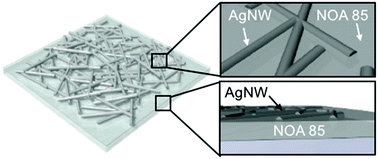Silver nanowire networks embedded in a cure-controlled optical adhesive film for a transparent and highly conductive electrode†
Abstract
A transparent conductive electrode (TCE) based on silver nanowire (AgNW) networks has been intensively studied as an alternative to indium tin oxide (ITO) for optoelectronic devices. However, for practical use, it has several critical issues, including high surface roughness, low adhesion between AgNWs and the substrate, poor contact junction between AgNWs, and severe oxygen corrosion. To resolve these issues, we present a novel AgNW-based TCE which is prepared by embedding AgNWs in the surface region of a photo-curable NOA 85 film. The key enabler of our work is the use of cure-controlled NOA 85 as a AgNW embedding matrix, the hardness of which can be tuned to allow the intrusion of the deposited AgNWs just below the surface under a low pressure of 2 MPa. The resulting AgNW/NOA 85 composite film exhibits an ultra-smooth surface, firm adhesion, high conductivity due to monolithically fused AgNW junctions, and outstanding oxidation stability, thereby leading to considerable improvements over as-deposited AgNW films or commercially available indium-tin-oxide (ITO) plastic films. In addition, we demonstrate a transparent touch panel by using the AgNW/NOA 85 composite film which outperforms a device with the ITO film.


 Please wait while we load your content...
Please wait while we load your content...